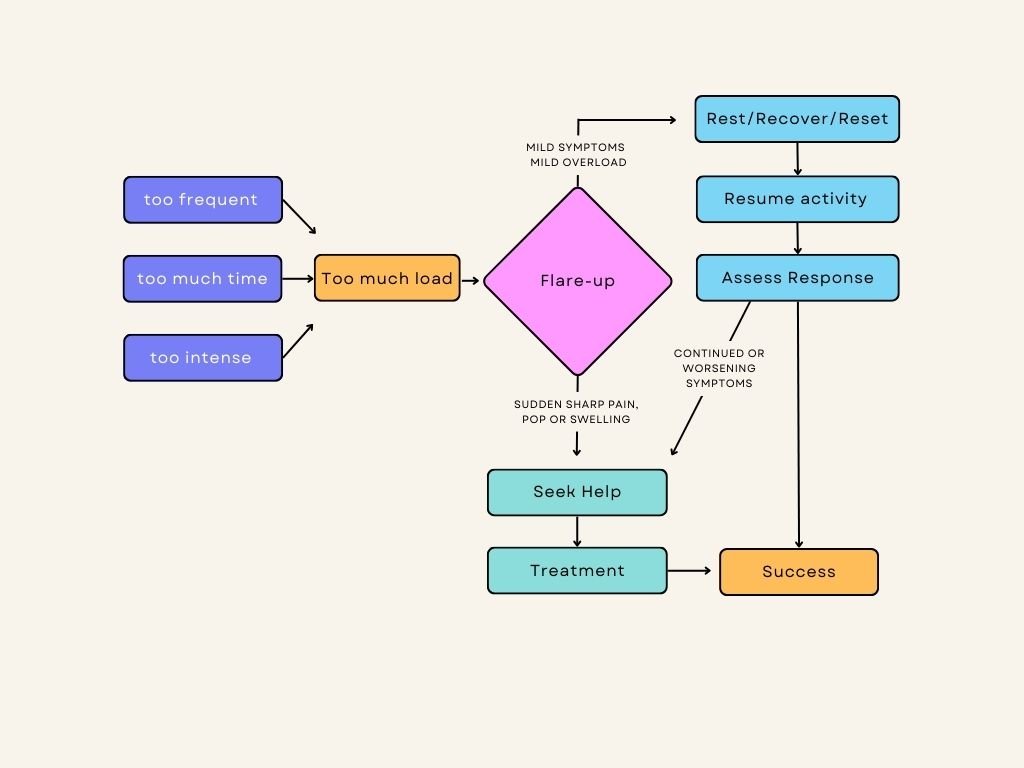Ask Coach Amy - What's a Flare-up?
I was doing great, and now I am in pain again. What happened? Am I ever going to get better? - anonymous patient
It is common to suffer a setback when rehabilitating an injury. I refer to these as flare-ups. They tend to happen when you start feeling good enough to resume more activity and when you no longer have a constant reminder of your injury.
What is a flare-up, and what causes them?
A return of your original symptoms is a sign of a flare-up; this might be pain, less range of motion, or decreased strength. Flare-ups typically occur when resuming activity "too much, too soon."
Let's look at three "flare-up" scenarios in a tennis player recovering from lateral epicondylitis (tennis elbow) - an injury to a tendon in the elbow. For the first time in months, she can grip her Yeti water bottle and swing her racquet without pain.
Scenario I - Too intense (resistance or speed)
She returned to strength class and used the same amount of resistance she did before her injury.
Scenario II - Too long
She played a competitive 90-minute tennis match.
Scenario III - Too frequent
She played tennis five days in a row: a private lesson, a group lesson, and three friendly matches.
It is not uncommon to see a patient simultaneously make all three mistakes. In each example, this patient resumed her previous activity level too soon. There was too much load on her tendon, resulting in a flare-up.
How do I avoid flare-ups?
Return to activities gradually to allow for adaptation to new loads. What does this mean?
Return to one activity at a time to prevent overloading and to assess which exercise or motion is most likely responsible for the flare-up. For example, the tennis player could choose between strength class or tennis until her tendon is stronger.
Return to activities with at least one day of rest/recovery between bouts to provide adequate time for the injured area to adapt to new loads and assess your body's response. For example, the tennis player could resume tennis lessons or matches three days per week with a rest day between each bout.
Return to activities with low intensity, gradually increasing as tolerated. The tennis player in our example could resume easy play, friendly non-competitive matches, or tennis lessons starting with 30 minutes at a time.
Does a flare-up mean the injury is back or worse, that it will never get better?
Not necessarily. If the error in return to activity is not prolonged or excessive and the flare-up is mild (less than 3/10 on the pain scale), you're unlikely to be re-injured.
Sometimes it is hard to rate your flare-up severity on the pain scale, especially if you are worried about it. Patients often wonder if their flare-up is in their heads. And sometimes, it is!
Worry and concern can create phantom injury pains and inflate a mild symptom into the scary red zone. Follow the steps outlined in the flowchart below to address a flare-up.
Who gets flare-ups?
Flare-ups can happen to anyone, including professional athletes, coaches, and even physical therapists! We used a tennis player in our example, but the rules apply to most injuries we see in orthopedic physical therapy.
For example, our flare-up example also applies to a mom with pain in her shoulder when she reaches back in the car to grab her purse. It also applies to a patient with back pain when she unloads the dishwasher and the triathlete that experiences numbness after 20 min on the bike.
What should I do in the event of a flare-up?
Take a few days to rest, recover and reset. Treat symptoms, reset expectations, and resume activities gradually. Schedule an assessment and treatment with your physical therapist if symptoms persist or worsen after a week.
If the return to activity is excessive or the flare-up is severe, you might need more time to recover and some physical therapy to get over the hump.
If you suffered sudden, sharp pain, felt a pop, or sudden loss of stability, you may have re-injured the structure or damaged a new one. See your physical therapist or other direct access health care provider as soon as possible.
Flare-up Take Aways
Flare-ups are normal and happen to everyone.
Take steps to avoid flare-ups.
Rest, recover and reset when a flare occurs.
Seek help if needed.
Need help?
CoachAmyPT can help you recover from your flare-ups!


